33 Brunswick Street West
Who Used to Live in this House?
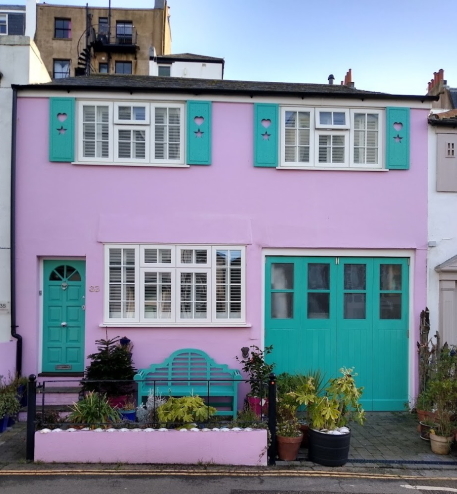
This is the house now in the 2020’s.
This is the house now in the 2020s. It has been re-numbered to 33 but it was once 47 Brunswick Street West (the rear of 47 Brunswick Square is just visible in the background of the picture). It is now a private residential house but what sort of building used to be here and who lived in it? Who actually lived in this building during that century of immense social change that began in the pre-Victorian 1820s and ended in the aftermath of The Great War?
Who lived in this house? Such a simple question, yet a question whose answer is complicated by matters of ownership and numbers but, first, we need to establish exactly what kind of a “house” it once was.
The street that became Brunswick Street West began life as a service street - a mews - developed in the 1820s to cater for the horse transport needs of the wealthy residents of Brunswick Town. Most of the properties on the east side of what became Brunswick Street West began as Coach Houses and Stables at the back of, and attached to, the grand houses on the west side of Brunswick Square. The number on the front property determined the number on the back. 47 was one such property.
There is though one further complication: it was not always numbered 47. Originally it was 45 Brunswick Square but from the mid 1830’s onwards was re-numbered 47. The “back part” of that property was what eventually became known as 47 Brunswick Street West
Early plans suggest that the Coach House, designed to be entered from the mews street, was 21 feet, 10 inches wide (same as the Brunswick Square frontage) and 35 feet deep. By 1843 - at the latest - the Coach House actually existed and was referred to in a bequest that was part of Maria Beecher’s will.
Right at the end of the 19th century we have an excitingly detailed description of the Coach House which was then being valued for Estate Duty purposes. In 1899 the property at the back of 47 Brunswick Square consisted of: a Double Coach House, 2 Stalls, a Loose Box, a Harness Room, 3 Living Rooms, a Loft and a WC. With a little imagination we can now picture this quite substantial building with its 2/3 floors serving both an equine and residential purpose and – important to understand - although a substantial building in its own right at this time it still formed part of the Brunswick Square property.
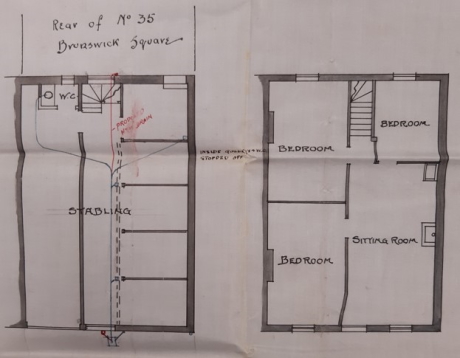
57 Brunswick Street West (previously No. 35), example of a single coach house before conversion – our building might have looked something like this
By the 1920s the importance of horse drawn transport had diminished and Brunswick Street West was developing an identity less dependent on its grander neighbour. It had also acquired its own more logical numbering system and the building that had been 47 - for about 90 years - was re-numbered 33. And 33 Brunswick Street West remains its address to this day.
Having established more about the nature of the building that became 47 Brunswick Street West, we can again ask the question: who actually lived in this building? Here follows a list, a simple list of names in chronological order, of the people who, the records suggest, once lived in this “house”.
- 1861 (07/04/1861. Source: 1861 Census) John Roberts (Coachman) & Edwin Chamberlain (Groom). (NB these two are listed among Thomas Withington’s 9 servants and it is possible they were living “upstairs” at 47 Brunswick Square).
- 1901-05 Albert Todman (Coachman) (31/03/1901.Source: 1901 Census + Electoral Roll list him as living here until 1905. In 1900 he was listed as living elsewhere at 2 Farm Road, Hove. Albert lived there with his wife Mary and 18-year-old daughter, Ada).
- 1907-09 James Robinson. Coachman Domestic and his wife Annie. (Source: Pikes 1907/08/09 Directories)
- 1911-13 Henry Rosbrook (Domestic Coachman), his wife Jane, two daughters Violet & Florence and two grandchildren. (02/04/1911. Source: 1911 Census + the Electoral Roll lists him as living here in 1912 and Pike Directory 1913).
- 1917-20 Charles & Alice Marchant. (Pike Directories 1917/18/19. Charles & Alice living in “House rear of 47” 1918/19 Electoral Rolls).
- 1920/21 Henry (Harry) Cyril (Searle) Dedman. (19/06/1921. Source 1921 Census).
- Mid 1920’s Robinson Motor Engineers (Pike Directory)
The most striking feature of this list of names is their occupation: Coachman – not surprising for the residents of a house that was located in a mews but what else can we glean about the lives that they lived. Can we turn these names into people?
In April 1861, Thomas Withington, a prosperous Magistrate, was Head of Household at 47 Brunswick Square. Thomas lived in this large elegant house with his wife, Cecilia, and their two young sons. Life for the Withington family was supported by the presence of nine resident servants. Amongst those servants were two whose duties would have been mainly outdoors: the Coachman - married 47-year-old John Roberts and a 17-year-old Groom, Edwin Chamberlain. Not much can be gleaned about John Roberts’ life beyond the fact that though married he was not accompanied by his wife. Perhaps she and perhaps their family lived in another part of the country, maybe in the county of Northamptonshire where John was born. Almost by definition Victorian coachmen led itinerant lives. We know that on the 7th April both John and Edwin were physically present in 47 Brunswick Square but where precisely did they sleep? It could have been – along with the other seven servants - in one of the small rooms on the fourth floor of 47 but far more likely it would have been somewhere in the stables and coach house at the back. We know they had been built by the 1860’s in the property that was, eventually, to be known as 47 Brunswick Street West (*1).
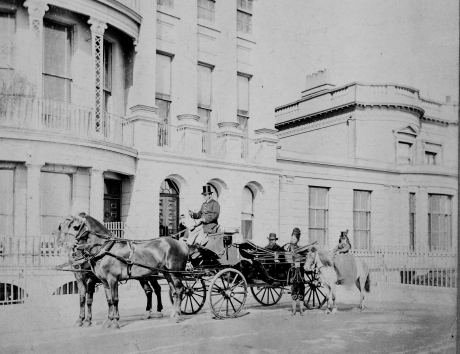
A Coachman & Carriage from 1860’s pictured in Brunswick Terrace. Source: Regency Society James Gray Collection
We know rather more about young Edwin. Coachman Roberts would have been his immediate boss and as there was no mention of a stable boy, 17-year-old Edwin would have been given most of the menial tasks. His regular duties would have included feeding, watering, sponging and combing the horses, cleaning the harnesses, removing the dung, polishing the carriage, tidying the stable and generally following the Coachman’s instructions.
Edwin was not a local Sussex boy. He was born in Wolvercote, a village just to the north of Oxford but like many country boys in Victorian Britain he had moved away to find suitable work opportunities. Perhaps his life in Hove was not too disagreeable: he had accommodation, food, probably a smart uniform when on duty and - maybe most important of all for Edwin - a sense that he was serving a kind of apprenticeship.
It is impossible for us now to quantify just how much Edwin may have learned from John Roberts about the skills, the duties and the responsibilities of being a Coachman but we do know about Edwin’s future. He was to spend almost all of his adult life - a long life - doing exactly that. 20 years later in 1881, Edwin, by then in his late 30’s, was living and working as a “Domestic Coachman” in Crumpsall, Lancashire. Married to wife Mary, they were bringing up a family of six: three boys and three girls. It is clear from this and other evidence that Edwin worked as a Coachman in the South Lancashire area for at least 40 years.
Mary was to pre-decease him, dying in the very first year of the 20th century, and so at the beginning of the 20th Century we find widower Edwin still working as a coachman. He was living with his youngest daughter, Lizzie, 22, single and employed as a dressmaker. 10 years after this Lizzie was still unmarried and living in the South Lancashire area but by then at a different address. With the help of a young Irish servant, “Aunt” Lizzy seemed to be caring for her eight-year-old nephew. As Head of the Household, Lizzy Chamberlain signed the 1911 Census form but there was no mention of her father.
For the first five years of the 20th Century, Albert Todman and his family were living at 47 Brunswick Street West (*2). Unsurprisingly, Albert was also a “Coachman”. He was 52 in 1901 and lived in the Coach House/ stables’ building with his Scottish wife, Mary, and their 18-year-old daughter, Ada. Albert was a career coachman so, ten years earlier for example, he was working as a “Domestic Coachman” in Hastings.
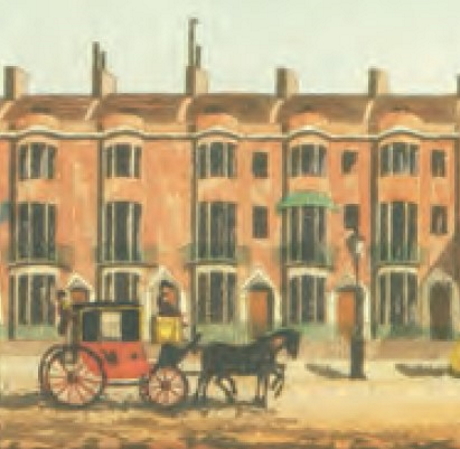
A coach with driver on the King's Road, Brighton
Albert was a Sussex man, born and baptised in Midhurst. Horse transport seems to have been the family occupation. Albert’s father was an ostler, working at one of Midhurst’s coaching inns. So, for Albert living in a mews street like Brunswick Street West it must have felt something like home. At the beginning of the 20th century, it was still a street filled with horses, carriages, stables and coach houses. We can almost smell the sweet aroma of horse manure.
The Electoral Roll for 1904 is illuminating as it indicates Albert was eligible to vote in the Brunswick Ward of the East Hove Polling District, then part of the Parliamentary Borough of Brighton. This might seem surprising to us but the reason for Albert’s eligibility was based on the fact of him living at the “back” of a substantial property like 47 Brunswick Square. And he was not alone. At least another 17 coachmen living nearby were similarly enfranchised by virtue of living in the stable buildings at the rear of the still grand Brunswick Square.
It’s tempting to wonder when Albert and some of his fellow coachmen met in The Star of Brunswick – it was right opposite his house – whether politics was a main topic of their conversation. Perhaps they were more concerned about the price of hay. Sadly, Albert died in 1905 although by an administrative oversight his name still appeared on the electoral roll for 1906 suggesting that his death may have been sudden and that he was still working as the resident Coachman at the time of his death.
By 1908 and 1909 James Robinson was the Domestic Coachman living at 47. James, born in 1855, came originally from Prestwich in Lancashire. With his wife Annie, he lived there for about two years. Annie came from Corsham in Wiltshire and was some 15 years younger than her husband. They appeared to have no children of their own although a few years later - when James was working and living in a different part of Hove – the couple were helping to look after Annie’s young niece, Edith.
The local Directories and Electoral Roll suggest that James Robinson only lived and worked at 47 for a relatively short period of time but the Censuses indicate that both before and after that period he was working elsewhere as a Domestic Coachman. So, it seems safe to assume that being a Coachman was his life career.
By 1911 Henry Rosbrook was the new Coachman living at 47 Brunswick Street West. Henry was born on a Suffolk farm and had spent all his life working with horses. For more than 30 years he had worked as groom and coachman in various parts of Cambridgeshire. For several years he was a groom at The Lamb, a famous Coaching Inn right next to Ely Cathedral. In 1911 Henry was 56 and living with Jane, his wife of 24 years and their two youngest children: Violet, 19- and 11-year-old Florence who was still at school. They had had six children altogether but, sadly, their eldest daughter had died and it appears that Henry and Jane had taken responsibility for their two young granddaughters as 6-year-old Vera and 5-year-old Violet were also living with them.
So, there were six members of the Rosbrook family living in the three rooms that constituted 47 Brunswick Street West. This was their census address and it is quite clear that this building was separate from the “front house” of 47 Brunswick Square. Henry however described his status as “worker” or employee which along with the fact that his right to a vote depended on him living in the residence at the “back” of 47 Brunswick Square seems to imply that his employer (and Landlord) was the Head of House at 47 Brunswick Square.
In 1911 that “Head of House” was John Whittome, a 74 year old retired farmer. In earlier years, as mentioned, Henry had worked in Ely and two of his daughters were born there. It may therefore be more than coincidental that Ely is so very close to where John Whittome used to farm his 700 acres. It is conjectural but quite possible that when the Whittomes retired from Suffolk to Hove they took with them a known, local coachman and his family.
There is an interesting political post script to this story. A rather strange entry is to be found on the Whittome Census Form. It is in the “Infirmities” column. In this column the Head of House is invited to record any “infirmity” experienced by a household member and John Whittome has written – in his own handwriting - “Shortage of money caused by excessive taxes of present government”! Perhaps this suggests John’s somewhat querulous disposition but more importantly it is a clear and pointed political reference - reference to the very heated party-political and economic battle that had been raging for the previous two years.
It was a time of great political turbulence. Asquith’s Liberal Government had been fighting to bring in a society-changing budget designed to alleviate poverty and fund social welfare projects. It has been described as the first real “redistributive” budget and it introduced unprecedented levels of taxation: a land valuation and tax, a supertax on the rich and increased death duties. It was the brainchild of The Chancellor, David Lloyd George, and his radical young supporter, Winston Churchill: “the terrible twins” as they were dubbed by their Conservative opponents. After much political wrangling and a constitutional crisis, the Liberals eventually succeeded. The matter was finally decided in the General Election of December 1910 but it had been highly divisive and left a residue of bitterness among many of those like John Whittome from the wealthier or landowning classes.
The 1911 Census took place less than 4 months after that election and it is clear from Whittome’s note that his bitterness had not subsided and that he held the Liberal Government to blame. He was, of course, a retired farmer and landowner. In retirement he and his wife were living alone (apart from two live-in servants) in what seems to us a grand and spacious 16 room mansion but perhaps he felt that his way of life was under threat.
But what of his Coachman? Henry also had the vote and - assuming he used it - where did his allegiances lie? Henry Rosbrook and his family of five must have found it a struggle living in those three rooms (perhaps shared with the horses) and in his mid 50’s did he expect to carry on working pensionless until he died?
That bitterly contested election took place just before Christmas 1910 but, alas, we can only guess about how Henry cast his vote. This was also a time of increasingly active and angry protest on behalf of the Votes for Women Movement but again we can only wonder about Henry’s wife Jane and his 19-year-old daughter, Violet. Did they have views about the window smashing and the other protests? At this time working class women like Jane and Violet were becoming more involved in these campaigns but again perhaps they were just ordinary people far more interested and excited about having seen the biplane that had just landed on Hove Lawns.
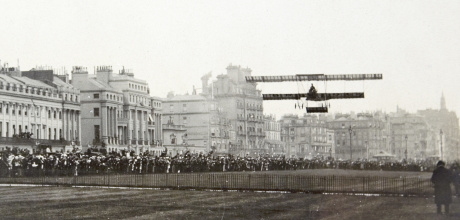
Mr Gilmore’s Flight from Hove Lawns 21 May 1911. Source: Regency Society James Gray Collection
(5) Charles and Alice Marchant lived in the house from 1917 until 1920. If the Rosbrooks’ tenure in the house coincided with a time of political and economic turbulence, by the time the Marchants arrived at 47 Brunswick Street West the world was trapped in catastrophic conflict. The war was in its third year when Charles Marchant he arrived at the house. He was 58 and he was the first person who was, very definitely not, from an equestrian background. He was a painter and decorator.
We know that Charles’ (and from 1918) Alice’s eligibility to vote was based on the fact of them living in a “house at the rear” of 47 Brunswick Square. This suggests that the Coach House was still owned by John Whittome but whether he employed Charles Marchant as a Coachman is open to doubt. Three years of fighting on the western Front had depleted the supply of horses and the men to look after them. It seems unlikely - but not impossible - that a House Painter in his late 50’s would suddenly change his profession. Perhaps he was enticed to Hove by the prospect of work and cheap rent in a now redundant coach house.
Charles was born and grew up in the Greenwich area of South East London. From a young man he had worked as a House Painter and this continued after his marriage to Alice. They had two sons, Walter and Norris, and for many years in the 1880’s and 90’s lived in Drysdale Road, Lewisham. By 1911 Charles was working as the House Painter at Granville House Prep School in Blackheath. This was, in its time, quite a prestigious establishment preparing 'young gentlemen' for entry into some of the country’s most famous public schools. There is a suggestion that Charles may also have been a 'Caretaker' at the School which would have involved wider responsibilities for maintenance of the building.
(6) In 1921 Henry Cyril Dedman is recorded as living at 47 Brunswick Street West. (Again I have some info about HCD but would like 2021 Census entry to try and nail it down)
(7) Finale. By 1925, John Whittome had died, 47 Brunswick Square had been sold and re-configured as flats and its former Coach House now provided the premises for GR Robinson: Motor Engineer.
This has been a story about (some of) the inhabitants of 47 Brunswick Street West, their involvement with horse transport and their connection with the grand house at the front. 47 Brunswick Street West was originally the Coach House for 47 Brunswick Square and when in 1925 that Coach House was re-purposed as a garage it seems to symbolise the end of an era and confirm that the connection between the two buildings - the front and the back - was finally and irrevocably broken.
*1 The property that after a C20th re-numbering became 33 Brunswick Street West
*2 The address is somewhat ambiguous as the building was still regarded legally as being at the “back of 47 Brunswick Square”.
Research by David Jackson, 2022
Return to Brunswick Street West page.


